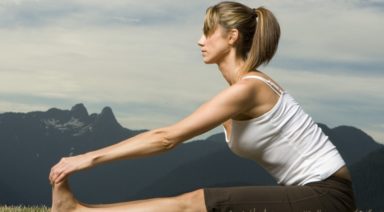Utkata Konasana: Goddess Pose

Utkata Konasana: Goddess Pose
Utkata konasana (oot-KAH-tuh cone-AHS-uh-nuh), also known as the goddess pose or fiery angle pose, is a pose to help activate base energy centers while stretching and toning the lower body. This pose helps connect to the inherent inner goddess, finding a common space with the powerful feminine energy.
PHILOSOPHY
As you practice utkata konasana, be conscious of the feminine energy at work. This energy can be felt throughout your daily life, both as a part of this pose, and also in your alignment of feelings, practices, and mantras everywhere you go.
STEP-BY-STEP
- Start in a wide standing stance. Turn your toes out and your heels in, so your feet are pointed out at about a 45-degree angle.
- Bend your knees in the same direction as your toes, and lower your hips down toward the height of your knees.
- Reach your arms out at shoulder height and bend your elbows so that your fingertips point skyward. Spread your fingertips wide and activate the muscles across your back.
- Engage your core muscles and draw your tailbone toward the floor. Keep your spine long.
- Stay here for 30 seconds to one minute, then release.
ADJUSTMENTS/MODIFICATIONS
- Place your hands together at the heart center to ease up on your shoulders.
SANSKRIT
- Utkata = powerful or fierce
- Kona = angle
- Asana = pose
PHYSICAL BENEFITS
- Stretches your hips, groin, and chest.
- Tones and strengthens the core muscles.
- Strengthens the quadriceps and inner thigh muscles.
- Heats the body and increases circulation.
ENERGETIC BENEFITS
- Encourages downward energy (apana).
- Activates root and sacral chakras.
PREPARATORY POSES
- Reclined bound angle pose | Supta baddha konasana
- Standing figure four pose | Eka pada utkatasana
- Garland pose | Malasana
SEQUENTIAL POSES
- Temple pose
- Side lunge pose
- Firefly pose | Titibasana
COUNTER POSES
- Wide-legged forward fold | Prosarita
- Standing forward bend | Uttanasana
- Eagle pose | Garudasana
###Legal Disclaimer Before participating in any exercise program or using any fitness products or services that may be described and/or made accessible in or through the Gaia Website and/or the Services, you should consult with a physician or other healthcare provider. Read more about Gaia’s Terms Of Use.
Ardha Matsyendrasana: Half Lord of the Fishes Pose

ADJUSTMENTS | BENEFITS | SEQUENCING | SANSKRIT | STEPS
Ardha matsyendrasana (ARE-dah MOT-see-en-DRAHS-ah-nah) is an approachable twist that opens the shoulders and chest. A good antidote for too much sitting and symptoms that come with overusing technology, half lord of the fishes pose has the ability to increase energy in the body while also stoking the digestive fire in your belly.
Philosophy + Origin
Matsyendra is often recognized as one of the original founders of hatha yoga in yogic mythology. He was said to be a baby who was thrown into the ocean after his parents rejected him. The story of Matsyendra reminds us that it’s often the parts of our personal stories we don’t like or don’t want to accept that can be the most beneficial, especially on the path to becoming a yogi or yogini. Rather than conceptualizing the twist to be a purge of what is unwanted or unnecessary, think of the detoxification as a purification, an opportunity to take what was once viewed or understood as “bad” and transform it into something that is helpful on your personal journey.




































